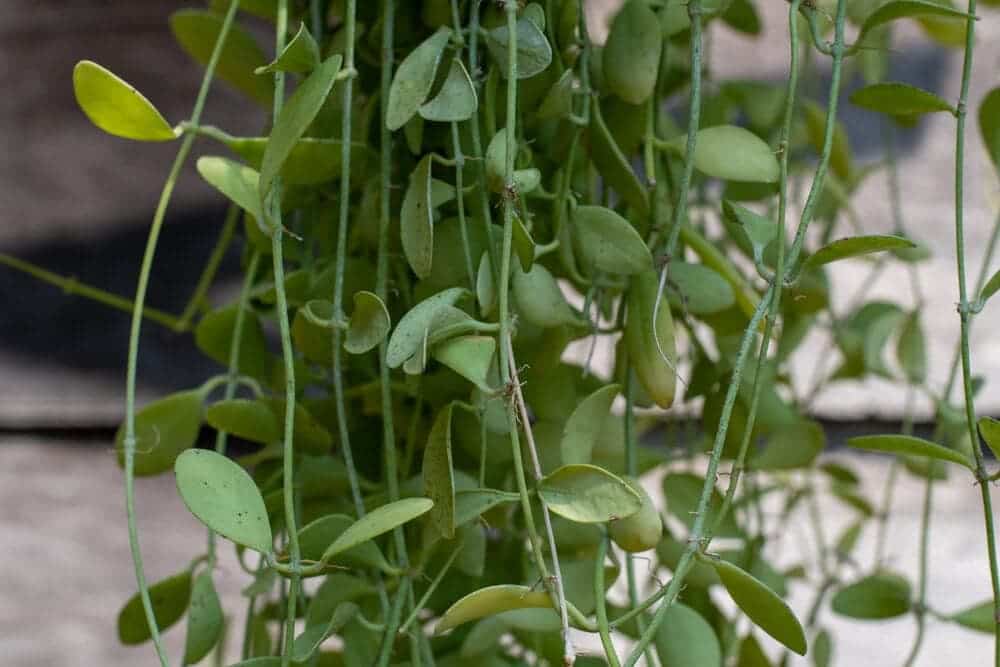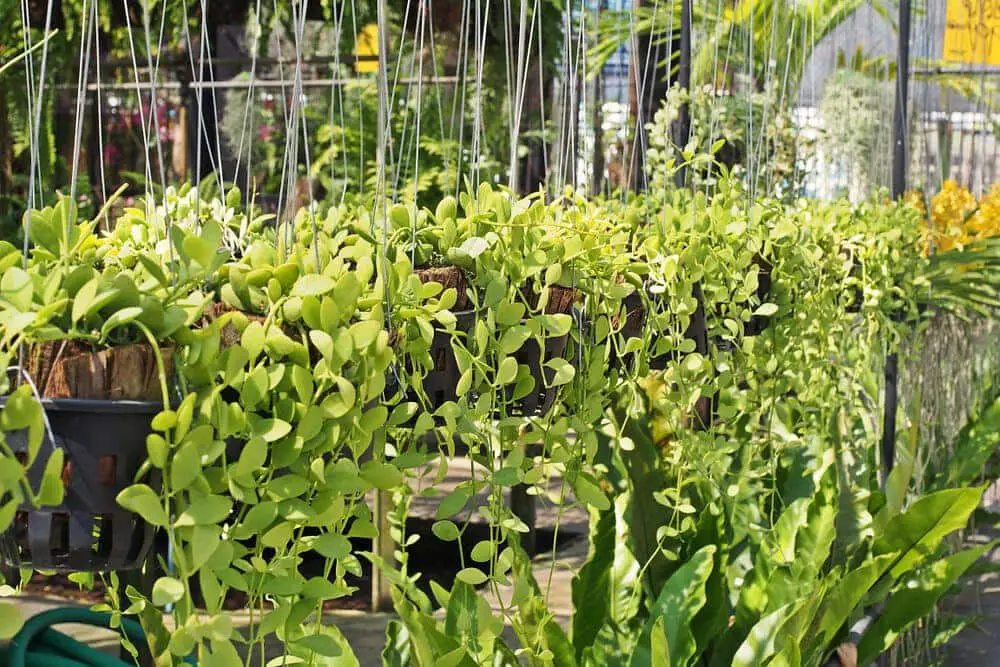The dischidia is a beautiful and exotic plant that doesn’t require a ton of effort to grow or maintain.
This plant is great for keeping inside the house or outside, making it very versatile.
Despite the low-maintenance nature of these plants, you’ll still need to know how to care for them.
Different Species:
First we will discuss some of the different types of Dischidia plants, as there are several.
1. Dischidia Vidalii
This particular plant species is characterized by very small red flowers and pouchy leaves that are completely hollow. It is also known as the Ant Plant, due to its tendency to attract ants.
2. Dischidia Ruscifolia
This variety of Dischidia can be easily identified by its heart-shaped leaves. The leaves on these plants take on a slight red coloration when they are regularly exposed to bright light.
3. Dischidia Ovata
This species of plant has leaves that resemble a watermelon with three distinct stripes across each one. They too can turn somewhat red when put out in direct sunlight for 4-5 hours each day.
4. Dischidia Nummularia
It is pretty common to see these plants growing around the trunks of trees, especially in Singapore, which is their native land. Its leaves and stems are both very small.
Dischidia Care & Growing Guide
1. Light Requirement
It is best to grow your Dischidia plant in a spot that does not receive direct sunlight. These plants need bright light, but direct exposure can irrevocably damage the leaves. If you are going to keep this plant inside, you should choose a window that faces south, east or west. This should provide the plant with adequate light without damaging it.
2. Water
You only need to water this plant every 2-3 days. Over watering can quickly lead to root rot, which will damage the plant beyond saving. You should allow the soil to become fairly dry but not bone dry between watering.
It’s also a good idea to keep a humidifier right by the plant and keep it running for just an hour on a daily basis. This will provide the plant with the moisture it needs to stay healthy over the short and long term.
3. Climate
These plants can grow in tropical climates in hardiness zones of 10 through 11.
4. Soil
The Dischidia plant needs loose soil that drains well. This will help with preventing root rot, which is a serious issue. You should look for a soil that is specifically meant for epiphytic plants. This soil is traditionally made up of shredded bark or coconut husk. Heavy potting soil should be avoided.

5. Temperature
These plants can tolerate temperatures of 40 to 80 degrees Fahrenheit. It is recommended that you bring them inside when it starts getting chilly. They cannot survive the winter months outdoors in non-tropical regions.
6. Repotting
While you don’t need to use any fertilizer on these plants, it is important that you repot them each year. This will ensure that your plants get all of the nutrients necessary to stay healthy and avoid disease.
Repotting this plant can be a bit tricky, as it tends to become rootbound fairly easily. If you notice the roots are tangled around the rootball, you’ll have to remove them gently. It can be easy to damage the root system, so you must keep this in mind.
7. Speed of Growth
Dischidia plants can grow very quickly, especially when they are kept in a high-humidity environment.
8. Height and Spread
These plants can grow up to 12 feet with a width of up to 40 feet, depending on the variety. You need to consider the particular variety of the Dischidia you are growing so it has enough space.
9. Flowers
The Dischidia pectenoides plant produces small red flowers that are quite striking and vibrant.
10. Trimming
Sometimes you may need to cut back the stems of this plant so they don’t grow out too far. Regular trimming is not necessary with these plants, which is one of the reasons they are such a popular choice.

Is the Dischidia Plant Poisonous?
The stems and leaves of the Dischidia plant have a sap inside of them that can cause dermatitis when exposed to the skin. These plants are not toxic when ingested by humans or pests. Not everyone who is exposed to this sap will experience irritation of the skin.
Can Dischidia Grow in Water?
Certain types of Dischidia plants can be grown in water. You simply have to strip the bottom leaves from the plant’s stems and put them in a vase filled with water. It will most likely grow fast this way.
How to get Dischidia Plants to Flower
The most effective way of getting Dischidia plants to flower is to keep them in a high-humidity environment with a consistent temperature of around 75 to 80 degrees Fahrenheit. Make sure that it is watered regularly and kept in a well-ventilated space.
Common Dischidia Diseases
Root rot is a big problem with Dischidia plants, and it’s usually a direct result of over watering. You will need to be very careful when it comes to making sure that your plant gets just the right amount of water on a regular basis.
Conclusion
- There are several types of Dischidia plants, some of which produce reddish-colored leaves when exposed to direct sunlight each day.
- You shouldn’t keep these plants in direct sunlight for more than a few hours per day. They need to be kept in a nice shady spot most of the time.
- Make sure that you water your Dischidia plant every two to three days. You should wait for the soil to get somewhat dry before watering it.
- These plants can be grown in hardiness zones of 10 and 11.
- You can keep Dischidia plants outside in temperatures of 40 to 80 degrees Fahrenheit.
- It is best to bring these plants inside during the colder months of the year.
- Repotting these plants can be tricky, as they often become rootbound. Take care not to damage the plant’s root system when transferring it to a larger container.
- While these plants are not poisonous if ingested, their sap can cause skin irritation with some people.
Victoria is the owner and main author of hobby plants. She loves spending her free time in her garden planting and taking care of her plants. Victoria hopes you enjoy the content here!
![Mother Of Thousands Plant [Complete Plant Care Guide] Mother Of Thousands Plant [Complete Plant Care Guide]](https://www.hobbyplants.com/wp-content/uploads/2022/07/mother-of-thousands-plant-300x158.jpg)
![Majesty Palm Plant Care: [Complete Beginner's Guide] Majesty Palm Plant Care: [Complete Beginner's Guide]](https://www.hobbyplants.com/wp-content/uploads/2022/08/majesty-palm-care-300x158.jpg)
![Exotic Angel Plant Care: [Complete Beginner's Guide] Exotic Angel Plant Care: [Complete Beginner's Guide]](https://www.hobbyplants.com/wp-content/uploads/2022/08/exotic-angel-plant-care-300x158.jpg)
![Snow White Waffle Plant: [Complete Care Guide] Snow White Waffle Plant: [Complete Care Guide]](https://www.hobbyplants.com/wp-content/uploads/2022/08/snow-white-waffle-plant-300x158.jpg)
![Waffle Plant Care: [Complete Beginner's Guide] Waffle Plant Care: [Complete Beginner's Guide]](https://www.hobbyplants.com/wp-content/uploads/2022/08/waffle-plant-300x158.jpg)
![Bird Of Paradise Plant Care: [Complete Beginner's Guide] Bird Of Paradise Plant Care: [Complete Beginner's Guide]](https://www.hobbyplants.com/wp-content/uploads/2022/08/bird-of-paradise-plant-300x158.jpg)
![Purple Passion Plant Care: [Complete Beginner's Guide] Purple Passion Plant Care: [Complete Beginner's Guide]](https://www.hobbyplants.com/wp-content/uploads/2022/08/purple-passion-plant-care-300x158.jpg)
![China Doll Plant Care: [Complete Beginner's Guide] China Doll Plant Care: [Complete Beginner's Guide]](https://www.hobbyplants.com/wp-content/uploads/2022/09/china-doll-plant-care-300x158.jpg)
![Polka Dot Plant Care: [Complete Beginner's Guide] Polka Dot Plant Care: [Complete Beginner's Guide]](https://www.hobbyplants.com/wp-content/uploads/2022/09/polka-dot-plant-300x158.jpg)
![Mona Lisa Lipstick Plant Care: [Complete Beginner's Guide] Mona Lisa Lipstick Plant Care: [Complete Beginner's Guide]](https://www.hobbyplants.com/wp-content/uploads/2022/09/lipstick-plant-mona-lisa-300x158.jpg)
![Yucca Cane Plant Care: [Complete Beginner's Guide] Yucca Cane Plant Care: [Complete Beginner's Guide]](https://www.hobbyplants.com/wp-content/uploads/2022/09/yucca-cane-plant-care-300x158.jpg)
![Bush On Fire Croton Plant Care: [Complete Beginner's Guide] Bush On Fire Croton Plant Care: [Complete Beginner's Guide]](https://www.hobbyplants.com/wp-content/uploads/2022/09/bush-on-fire-croton-300x158.jpg)